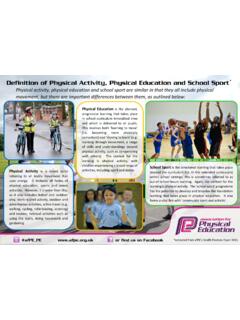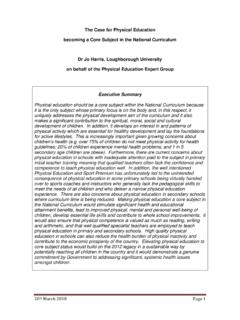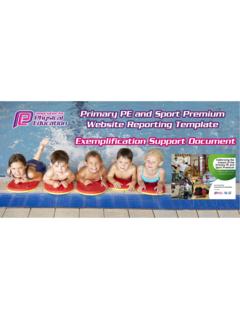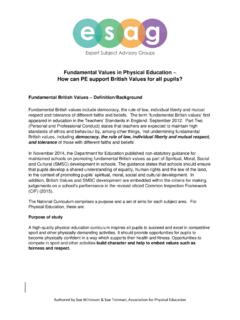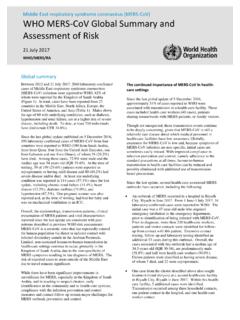Transcription of Guidance on Assessment: National Curriculum (2014)
1 Page 1 The Physical Education Expert Group Guidance on assessment : National Curriculum ( 2014 ) Members of the Physical Education Expert Group November 2014 Page 2 Introduction The following statement and Guidance has been developed by members of the Physical Education Expert Group and highlights key assessment principles outlined in the publication assessment Principles (DfE, 2014 ). Effective assessment in physical education engages supports and motivates pupils to become competent, confident, creative and reflective movers. It can support and encourage young people to work together in order to excel in physically demanding and competitive activities. Approaches to assessment must be meaningful and embedded throughout a high quality physical education Curriculum ; which enables learners to make progress and improve their attainment.
2 Although locally determined and child-centred, physical education must be situated within a whole school approach to assessment and support a child s development across the whole Curriculum . The National Curriculum ( 2014 ) The National Curriculum ( 2014 ) sets out the aims, purpose of study and content for physical education. Although it does not specify a detailed overview of the nature and content of learning, it presents the expectations that pupils should reach by the end of each key stage. These expectations are considered a minimum entitlement and schools should be encouraged to devise a Curriculum programme that is aspirational and is based on the needs of its pupils. The statements below outline the key attainment targets for each key stage within the physical education programme of study: Key Stage One: Pupils should develop fundamental movement skills, become increasingly competent and confident and access a broad range of opportunities to extend their agility, balance and coordination, individually and with others.
3 They should be able to engage in competitive (both against self and against others) and co-operative physical activities, in a range of increasingly challenging situations Key Stage Two: Pupils should continue to apply and develop a broader range of skills, learning how to use them in different ways and to link them to make actions and sequences of movement. They should enjoy communicating, collaborating and competing with each other. They should develop an understanding of how to improve in different physical activities and sports and learn how to evaluate and recognise their own success. Key Stage Three: Pupils should build on and embed the physical development and skills learned in key stages 1 and 2, become more competent, confident and expert in their techniques, and apply them across different sports and physical activities. They should understand what makes a performance effective and how to apply these principles to their own and others work.
4 They should develop the confidence and interest to get involved in exercise, sports and activities out of school and in later life, and understand and apply the long-term health benefits of physical activity Key Stage Four: Pupils should tackle complex and demanding physical activities. They should get involved in a range of activities that develops personal fitness and promotes an active, healthy lifestyle. Page 3 Teachers need to consider the key areas of learning and assessment that characterise each key stage (see tables 1 and 2 blow). Each key stage identifies the key areas for learning and assessment in physical education, as depicted by the attainment targets in the programme of study. Table 1: Primary physical education key areas for assessment Key Stage 1 Develop fundamental movement Physically motivated and confident Socially engaged Key Stage 2 Applies and develops movement Effective in working together Reflective learners Fundamental movement skills Agility, balance and coordination Competes with self Competes with others Cooperates with others Physical confidence Can evaluate and recognise success Apply skills in different ways Link and sequence actions Communicate Collaborate Compete How to improve in sports and activities Evaluate and recognise success Table 2.
5 Secondary Physical Education key areas for assessment Key Stage 3 Physically confident Physically skilful Breadth of experiences Health and enjoyment Key Stage 4 Self-Challenge Physical fitness Decision making Physically competent Expert techniques Apply across a broad range Effective performance Confident and interested Benefits of physical activity Complex Demanding Range of activities Personal fitness Health assessment Principles a) Allows for meaningful tracking of pupils towards end of key stage expectations in the new Curriculum , including regular feedback to parents. Physical Education Context: This refers to pupils progress in physical education linked to the attainment statements outlined within the programme of study. These statements detail the assessment focus for each key stage as a minimum entitlement for pupils (see tables 1 & 2).
6 Schools are encouraged to extend and challenge their learners through assessment beyond this statutory entitlement and across a broad and balanced Curriculum . As a minimum expectation, teachers are required to track pupils progress across the areas of learning in the attainment target (see table 1). Key questions from this assessment principle: Do you know the key assessment areas for each key stage? How does your Curriculum enable these areas of learning to be developed regularly and progressively across the key phases? Do you track pupils progress across these areas? Give reliable information to parents about how their child, and their child s school, is performing Page 4 Do you challenge and extend learning beyond the minimum entitlement, which supports the vision of being physically educated within your school context?
7 Who is involved in tracking pupils progress in your school ( teacher, coaches, swimming teacher, parent helpers, pupils etc.)? b) Provide information which is transferable and easily understood and covers both qualitative and quantitative assessment . Physical Education Context: assessment in physical education should record information in a way that is easily understood by pupils, parents and other colleagues. Quantitative assessment may be appropriate in key stages that require subject examination and formal National testing ( at KS4). Each child should have, as a minimum entitlement, evidence tracked against their progress towards the statutory key stage attainment target (see the above principle for what this should include at each key stage). For example, at key stage one how have pupils progressed in their fundamental movement skill learning across Year one and two?
8 How do you know? Do teachers use observational check tools or video evidence to profile a child as they make progress? Key questions from this assessment principle: How do you record pupils progress in physical education? Do you record progress in a broad and balanced range of activity areas? How often does the monitoring of progress in physical education take place? Is evidence of pupil learning shared with parents, pupils and other teachers? If so, how? Are the recording systems used easily understood and meaningful? How do you know and how are these evaluated? c) Differentiate attainment between pupils of different abilities, giving early recognition of pupils who are falling behind and those who are excelling. Physical Education Context: Inclusive teaching approaches should always be adopted when planning for physical education.
9 assessment and review of the learning outcomes need to be linked to the needs of the child and the statutory National Curriculum Guidance . For example, at KS1, pupils progress should be recognised in regards to development across the fundamental movement skills of running, jumping, throwing, and catching. assessment can help identify children who do not make progress against these outcomes as well as those exceeding expected progress which children are struggling with performing the skill with balance and coordination and which are adopting more specialised techniques. Appropriate and differentiated intervention should be applied to ensure maximum progress is made for all pupils. assessment therefore, is used to inform planning and enables learning to meet pupils needs. Key questions from this assessment principle: Are learning outcomes achievable for all learners?
10 Is differentiation used effectively to help learners make progress? If pupils are not making progress, how are they supported? Page 5 If children exceed expectations, how are they challenged further? How is enrichment opportunities used outside the Curriculum to support or extend learners? Do assessment approaches allow for all learners to be effectively monitored? d) assessment information is reliable and free from bias. Physical Education Context: Teachers should adopt a range of assessment approaches that motivate young people to make progress pupil-led assessment , peer assessment techniques, self- assessment and reflection, use of video, journals, whole-class discussion and teacher assessments. Evidence collected on pupil progress should be free from bias and reflect the breadth of learning within the physical education Curriculum .
